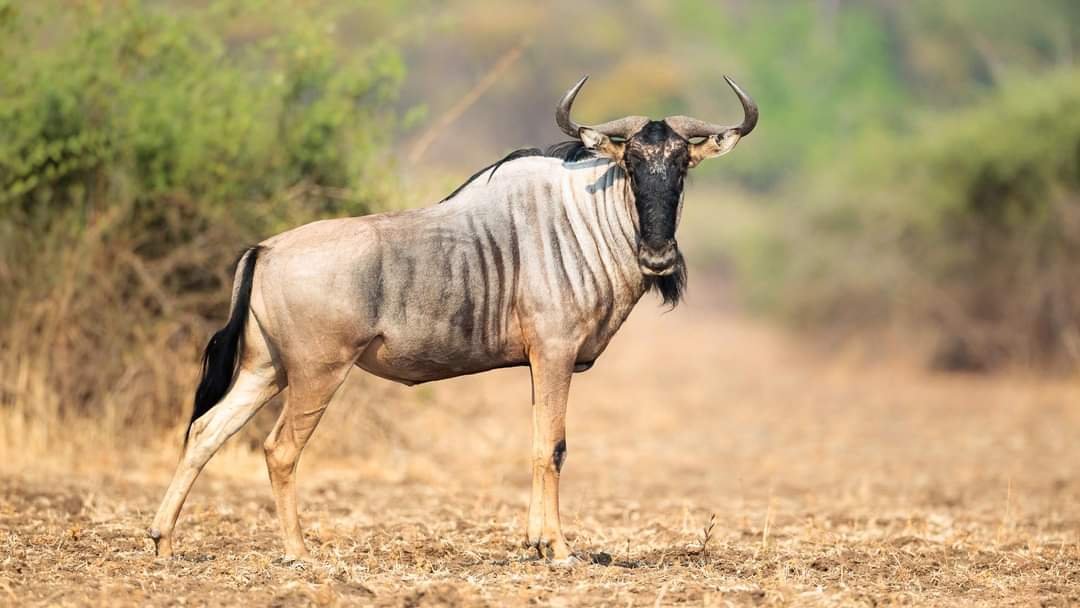Luangwa Wildebeest
( Black-bearded wildebeest or Cookson’s wildebeest )
- Connochaetes taurinus cooksoni
- IUCN Status: Least Concern
- Trend: decreasing

- Kingdom: Animalia
- Phylum: Chordata
- Class: Mammalia
- Order: Artiodactyla
- Family: Bovidae
- Subfamily: Alcelaphinae
- Genus: Connochaetes
Share:
General Information
The Luangwa wildebeest is a subspecies of the blue wildebeest. It is endemic to Zambia’s Luangwa valley.
The alternative name “gnu” originates from the name for these animals used by the Khoikhoi people, a native pastoral people of southern Africa. The Khoikhoi may have named them this due to the “Ga-Nuu” sound they make.
Fun Facts
The Luangwa Wildebeest are endemic to Zambia’s Luangwa valley.
They have a black beards compared to the blue wildebeest which has a white beard.
Description
This broad-shouldered antelope has a muscular, front-heavy appearance, with a distinctive, robust muzzle. Cookson’s wildebeest have a lighter coat than the blue wildebeests and a black beards with a slightly larger size. It has dark stripes running down the torso. Both sexes possess a pair of large curved horns.- Shoulder height: 115–145 cm
- Length: 170–240 cm
- Weight: 140 to 290 kg
- Lifespan: avg life span is 20 yrs in the wild and 21 yrs in captivity
Ecology & Behaviour
The Luangwa wildebeest is a herbivore, feeding primarily on the short grasses which commonly grow on light, and alkaline soils that are found in savanna grasslands and on plains. When grass is scarce, it will also eat the foliage of shrubs and trees. Wildebeest commonly associate with plains zebras as the latter eat the upper, less nutritious grass canopy, exposing the lower, greener material which the wildebeest prefer.
The Luangwa wildebeest is mostly active during the morning and the late afternoon, with the hottest hours of the day being spent in rest. Bulls mark the boundaries of their territories with heaps of dung, secretions from their scent glands, and certain behaviors. Body language used by a territorial male includes standing with an erect posture, profuse ground pawing, and horning, frequent defecation, rolling and bellowing, and the sound “ga-noo” being produced. When competing over territory, males grunt loudly, paw the ground, make thrusting motion with their horns, and perform other displays of aggression.
Conservation
The International Union for Conservation of Nature and Natural Resources rates the Cookson’s wildebeest as being of least concern.
Distribution & Habitat
The Cookson’s wildebeest is endemic to Zambia in the northern luangwa valley and on occasion they migrate to Malawi. They are an isolated group of wildebeest and are protected within the luangwa national parks.
Interaction with Humans
Major human-related factors affecting populations include large-scale deforestation, the drying up of water sources, the expansion of settlements and poaching. Diseases of domestic cattle such as sleeping sickness can be transmitted to the animals and take their toll. Traditionally, blue wildebeest have been hunted for their hides and meat, the skin making good-quality leather, though the flesh is coarse, dry, and rather tough. They can compete with domestic livestock for grazing and water and can transmit fatal diseases like rinderpest to cattle and cause epidemics among animals. They can also spread ticks, lungworms, tapeworms, flies, and paramphistome flukes.
No donation to this project yet.
| M | T | W | T | F | S | S |
|---|---|---|---|---|---|---|
| 1 | 2 | |||||
| 3 | 4 | 5 | 6 | 7 | 8 | 9 |
| 10 | 11 | 12 | 13 | 14 | 15 | 16 |
| 17 | 18 | 19 | 20 | 21 | 22 | 23 |
| 24 | 25 | 26 | 27 | 28 | ||


